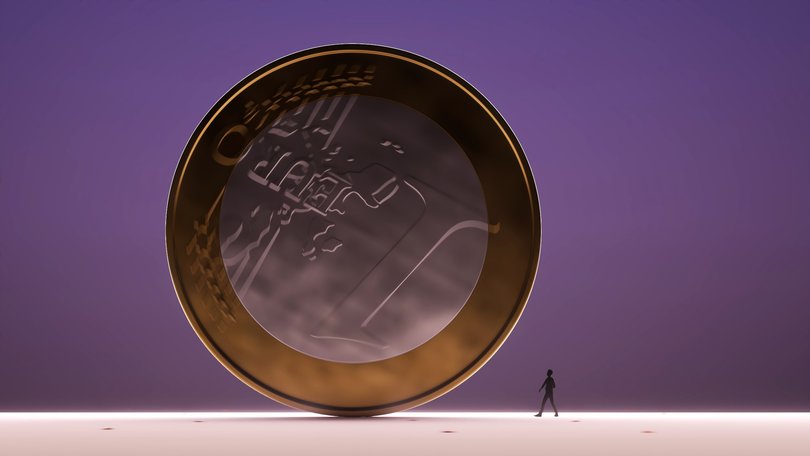THE NEW YORK TIMES: As the dollar slides, the euro is picking up speed

The chaotic rollout of President Donald Trump’s tariffs has prompted investors to question long-held assumptions about the safety and stability of the US dollar, which has plunged in value this year. In the hunt for alternatives, many have turned to the euro.
The euro has risen more than 11 per cent against the dollar since the start of the year, reaching its highest level in four years, at $1.18. The euro has also gained against other major currencies over that period, including the Japanese yen, British pound, Canadian dollar and South Korean won, suggesting that its strength is more than a reflection of the dollar’s weakness.
Christine Lagarde, the president of the European Central Bank, said this moment was an opportunity for the euro to gain global clout.
Sign up to The Nightly's newsletters.
Get the first look at the digital newspaper, curated daily stories and breaking headlines delivered to your inbox.
By continuing you agree to our Terms and Privacy Policy.“We are witnessing a profound shift in the global order: Open markets and multilateral rules are fracturing, and even the dominant role of the US dollar, the cornerstone of the system, is no longer certain,” she wrote last month.
The dollar’s role as the world’s reserve currency gives the United States an “exorbitant privilege” — a term coined begrudgingly by a French politician in the 1960s. Because investors, governments and central banks around the world seek the safe, predictable returns of dollar-denominated assets such as Treasury bonds, there is a robust, built-in demand for dollars. That makes it easier for the US government to borrow and boosts the spending power of American consumers.
The eurozone, which is made up of the 20 countries that use the euro and rivals the United States in terms of size and wealth, has never attracted investors in the same way. The euro ranks a distant second to the dollar in global use.
The euro’s recent rise is a major reversal from just three years ago, when it dropped to parity with the dollar because investors feared the damage of surging inflation and Russia’s invasion of Ukraine. And it is a world away from the euro-zone debt crisis last decade, when at times the currency union seemed at risk of crumbling.
As welcome as the euro’s recovery from those episodes has been — the euro is trading near a record high against the currencies of dozens of major trading partners — it is also possible to have too much of a good thing.
As money flows into the euro and euro-denominated assets such as German government bonds, economists and executives warn that the currency’s strength could hurt exporters. They are already contending with Trump’s tariffs, which make their goods more expensive for buyers abroad, as well as increased competition from Chinese rivals in key markets.
“Further euro strength is likely to be self-defeating,” said Valentin Marinov, a currency strategist at Crédit Agricole, a French bank. Exports were already likely to weaken and become a drag on the eurozone economy because of US tariffs and European government policies that would encourage more imports.
After a surge in energy prices led to years of fighting to bring inflation down, the European Central Bank, which sets interest rates for the eurozone, now faces the prospect that inflation could be too low.
The bank forecasts inflation to average 1.6 per cent next year, notably below its 2 per cent target. That’s partly because of the impact of a strong euro, which makes imports cheaper.
Some policymakers have said there is a risk that sluggish inflation will become entrenched, which is a familiar problem for the region. For nearly a decade until 2021, the central bank kept its key interest rates below zero in hopes of spurring faster economic growth and encouraging prices to rise steadily. That, policymakers hoped, would feed through to higher wage growth and better living standards.
ECB officials are expected to keep interest rates steady when they meet this week, but analysts are adding to bets they could cut rates again later this year, if the economic outlook darkens or the euro’s strength pushes inflation forecasts even lower. Reducing interest rates tends to weaken a currency, but the euro’s recent strength has come, notably, as the ECB cut rates eight times in a year.
Luis de Guindos, the vice president of the central bank, said that if the euro climbed above $1.20, that “would be much more complicated.”
Some big European companies have warned about the effect of the strong currency on their earnings, especially in export-heavy Germany.
SAP, a software firm that recently became Europe’s most valuable public company, said every 1-cent increase in the euro-dollar exchange rate results in a 30 million euro decline in revenues, without currency hedges. Adidas, the sportswear brand, said a strong euro had “negative translation effects” on its overseas sales. Daimler, a truck maker, said fluctuations in the euro-dollar rate “could significantly impact” its financial performance.
Where the euro goes next is hard to predict.
Analysts surveyed by Bloomberg expect the euro to continue strengthening, to $1.21 next year. But Marinov said he believed that traders had gotten ahead of themselves: He expects the euro to fall back toward $1.10 next year.
The currency’s rally this year does not necessarily mean there will be a lasting shift toward the euro, in which it accounts for a larger share of central banks’ reserves or is used in more cross-border payments.
Lagarde said seizing the moment for a “global euro” would take a concerted effort to bolster the bloc’s fragmented economy, streamline its governance and deepen its capital markets, among other things. “A step towards greater international prominence for our currency will not happen by default: It must be earned,” she said.
This article originally appeared in The New York Times.
© 2025 The New York Times Company
Originally published on The New York Times
